
Homogeneous Catalysis
.pdf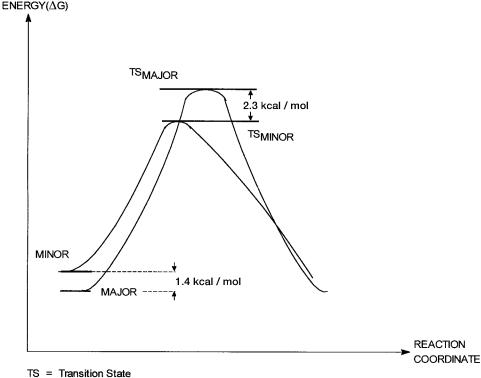
206 ASYMMETRIC CATALYSIS
reactions of the two diastereomers 9.19 and 9.20 with dihydrogen have also been separately studied by low-temperature NMR. The results of these studies are consistent with the above-mentioned mechanism for enantioselection. The X-ray structure of an analogue of the major isomer with a different chelating phosphine (S,S-chiraphos) has been reported. Using an achiral chelating phosphine, an analogue of 9.23 and 9.24 has also been identified by multinuclear NMR.
The detailed kinetic and thermodynamic data relating to the stabilities of 9.19, 9.20, and the activation energy barriers for the oxidative addition of dihydrogen can be summed up in the free-energy diagram shown in Fig. 9.5. The most interesting point of this diagram is the fact that the two free-energy profiles cross each other near the transition states. This is because the thermodynamically more stable major isomer has a transition state that is higher in energy than that of the minor isomer. Note that the free energies of the
Figure 9.5 Free energy diagram for the oxidative addition of dihydrogen to the two diastereomers of [Rh(R,R DIPAMP)(S)] , where S = methyl-(Z)- -acetamidocinamate. The “major” and “minor” refer to intermediates 9.19 and 9.20, one of which has higher equilibrium concentration than the other. The one with higher equilibrium concentration is called the major, and the other is called the minor isomer.
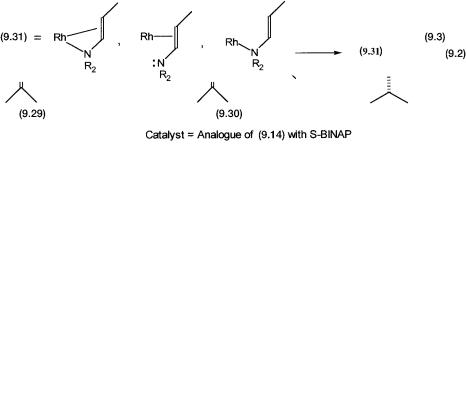
MECHANISMS AND CATALYTIC CYCLES |
207 |
products 9.21 and 9.22 are arbitrarily fixed. Their diasteromeric relationship means that they need not have identical energies. The important point is that the free energies of activation, rather than free energies of the starting complexes, determine the enantioselection process.
9.3.2Asymmetric Isomerization and Mechanism
Like the synthesis of L-DOPA by asymmetric hydrogenation, the manufacture of L-menthol by Takasago Company is also one of the early examples of an industrial process where asymmetric isomerization is a key step. The desired isomerization reaction is one of the steps of the overall synthetic scheme. The synthesis of L-menthol from diethyl geranylamine is shown by 9.2. The formal electron pair pushing mechanism for the isomerization of the allylic amine to the enamine proceeds according to reaction 9.3.
The enamine in 9.31 can coordinate to the metal center in three different ways. It can act as a monodentate ligand by coordinating either through the N atom lone pair or the double bond. It can also act as a chelating ligand. As we will see, the proposed catalytic intermediates in the catalytic cycle have all three different types of coordination.
A simplified proposed catalytic cycle is shown in Fig. 9.6. The precatalyst, an analogue of 9.14 with S-BINAP, undergoes reaction 9.3 to generate 9.32, where the enamine acts as a chelating ligand. Note that in 9.32 asymmetric isomerization has already taken place. How this may come about will be dis-
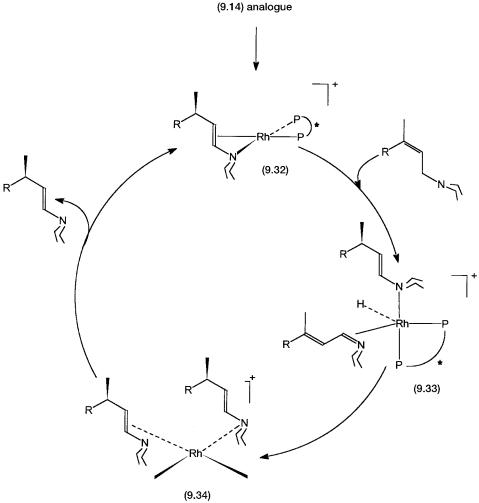
208 ASYMMETRIC CATALYSIS
Figure 9.6 Catalytic cycle for the asymmetric isomerization of diethylgeranylamine. The precatalyst is an analogue of 9.14 with S-BINAP in place of DIPAMP. Conversions of 9.14 to 9.32 and 9.32 to 9.33 involve more than one step (see Problem 9). These are not shown for clarity.
cussed shortly. Although shown as a single step, the conversion of 9.32 to 9.33 involves two reactions. First, coordination by a molecule of the allyl amine 9.29 causes the enamine to act as a monodentate ligand that coordinates only through the nitrogen lone pair. This is followed by hydride abstraction from the -carbon of 9.29 and the generation of the hydride complex 9.33.
Note that in 9.33 hydride abstraction generates quaternary nitrogen containing conjugated allyl amine ligand. This prochiral molecule coordinates to the
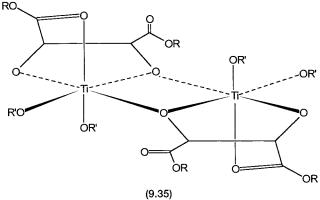
MECHANISMS AND CATALYTIC CYCLES |
209 |
metal through the carbon–nitrogen double bond. Conversion of 9.33 to 9.34 is the step where the H atom is added to the -carbon in a stereospecific manner. Presumably, the chiral environment around the metal center ensures that the hydride transfer on one enantioface is kinetically preferred. In 9.34 both the enamine molecules act as monodentate ligands. One of them coordinates through the alkene functionality, but the other uses the nitrogen lone pair. Chelation by any one of them leads to product formation, that is, elimination of the other enamine molecule as the product. This regenerates 9.32 and completes the catalytic cycle.
9.3.3Asymmetric Epoxidation of Allylic Alcohols and Mechanisms
In epoxidation reactions allyl alcohol can act as a prochiral alkene. Enantiomerically pure glycidol isomers (see Table 1.1) may be used to make S- propanolol 9.61, a drug for heart disease and hypertension. The mechanistic details of the epoxidation reaction with V5 and Mo6 complexes as catalysts were discussed in Section 8.6. The basic mechanism of epoxidation reaction, the transfer of an oxygen atom from t-butyl hydroperoxide to the alkene functionality, remains the same.
The chiral precatalyst is a titanium species. It is generated by the in situ treatment of titanium isopropoxide with diethyl or diisopropyl tartarate. The relative amounts of Ti(OPri)4 and the tartarate ester have a major influence on the rate of epoxidation and enentioselectivity. This is because the reaction between Ti(OPri)4 and the tartarate ester leads to the formation of many complexes with different Ti:tartarate ratios. All these complexes have different catalytic activities and enantioselectivities. At the optimum Ti:tartarate ratio (1:1.2) complex 9.35 is the predominant species in solution. This gives the catalytic system of highest activity and enantioselectivity. The general phenomenon of rate enhancement due to coordination by a specific ligand, with a specific metal-to-ligand stoichiometry, is called ligand-accelerated catalysis.
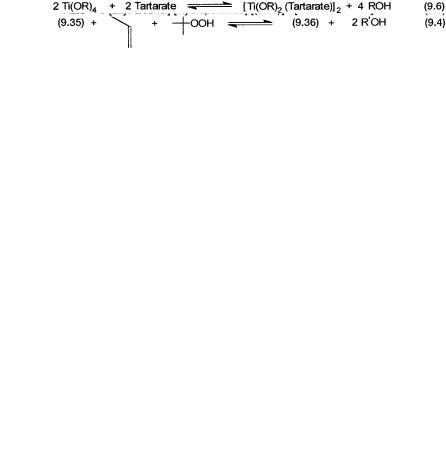
210 ASYMMETRIC CATALYSIS
Before discussing the structural evidence for the precatalyst 9.35, we quickly go through the proposed mechanism of epoxidation. The precatalyst 9.35 reacts with one mole each of allyl alcohol and t-butyl hydroperoxide to give 9.36, where two alkoxide ligands on the same Ti atom are substituted according to reaction 9.4.
The proposed catalytic cycle and the structure of 9.36 are shown in Fig. 9.7. Nucleophilic SN2-type attack by the olefin to the distal oxygen atom produces the epoxy alkoxide. The chiral environment around the Ti atom ensures that the allyl alcohol is oriented in such a way that O atom transfer takes place only on one particular enantioface. The discrimination between the two possible faces is “stereoelectronic” rather than “steric” in nature. The epoxy alkoxide is then replaced by allyl alcohol to give the epoxy alcohol and 9.37. The latter can react with more t-butyl hydroperoxide to regenerate 9.36.
The evidence for the proposed mechanism comes from kinetic, spectroscopic (multinuclear NMR), X-ray structure, and theoretical calculations. The kinetic rate law under optimum catalytic conditions is very complex. Under pseudo- first-order conditions, where the concentrations of both 9.35 and the hydroperoxide are much greater than that of allyl alcohol, the rate expression 9.5 is obeyed. In this expression the inhibitor alcohol is an inert alcohol such as isopropanol or t-butanol that is deliberately added to slow down the reaction for convenient rate measurements. The inert alcohol acts as an inhibitor, since it competes with both hydroperoxide and allyl alcohol for coordination to the Ti center. Note that expression 9.5 is consistent with the formation of an intermediate like 9.36, before the rate-determining oxygen atom transfer step.
The equilibrium as shown by 9.6 has been observed by NMR, and the product formed in solution has been shown to be dimeric in nature by molecular weight measurements and multinuclear NMR. The proposed structure, 9.35, has two inequivalent CO2R groups. One of these is bonded to the Ti center, while the other is free. X-ray structures of several Ti–tartarate complexes have also been determined, and they all exhibit the general structural features of 9.35. In other words, there is good evidence to suggest that the solid-state structure of 9.35 is retained in solution, and this species indeed is the true precatalyst.
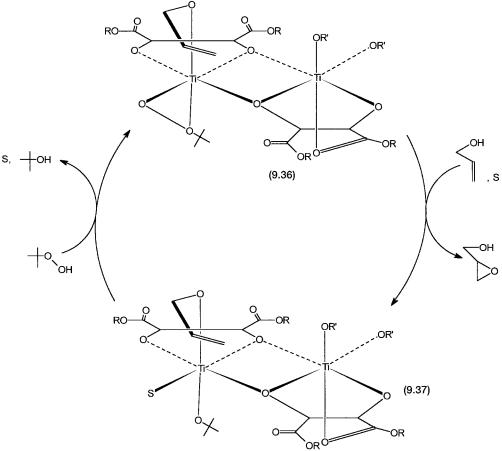
MECHANISMS AND CATALYTIC CYCLES |
211 |
Figure 9.7 Catalytic cycle for asymmetric epoxidation of allyl alcohol with 9.35 as the precatalyst. The precatalyst is generated in situ and undergoes conversion to 9.36 in the presence of allyl alcohol and t-butyl hydroperoxide. S is a solvent molecule. Conversion of 9.36 to 9.37 involves more than one step. This is not shown for clarity (see Problem 10).
9.3.4 Asymmetric Epoxidation of Alkenes Other Than
Allyl Alcohols
It is clear that in the asymmetric epoxidation of allyl alcohols, coordination by the OH functionality to the titanium center plays a crucial role. Such a coordination has a favorable effect on the entropy of activation, that is, the rate constant (see Question 14 of Chapter 8). It also helps to orient only one of the two possible enantiofaces for a facile oxygen atom transfer. With alkenes that do not have any such functional groups, the titanium tartarate system gives poor enantioselectivities. The precatalyst that has been found to exhibit re-
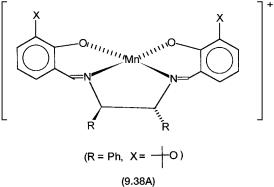
212 ASYMMETRIC CATALYSIS
markably high enantioselectivities for such alkenes is a planar manganese complex 9.38A with an optically active Schiff-base ligand. In these reactions, instead of ButOOH, iodosyl benzene (PhIO) or NaOCl is used as the oxygen atom donor.
The proposed mechanism for epoxidation with 9.38B as the catalyst is shown in Fig. 9.8. The oxidation state of manganese in 9.38A and 9.38B is three. The oxygen donor NaOCl or PhIO oxidizes Mn3 to Mn5 , and an oxo complex such as 9.39 is produced. Reaction of 9.39 with the alkene produces the chiral epoxide and regenerates 9.38B. While there is enough evidence for the basic mechanism and the involvement of a catalytic intermediate such as 9.39, there is some controversy about the details of the oxygen atom transfer from 9.39 to the alkene.
Two alternative mechanisms have been proposed. A direct substrate attack at the oxo ligand with concerted or sequential C–O bond formation is possible. Alternatively, the substrate may attack at both the metal and oxo centers to generate an oxametallocyclic intermediate. These two alternatives are shown in Fig. 9.9. Finally, note that in CytP450-catalyzed hydroxylation and epoxidation, an iron porphyrin intermediate of the type of 9.39 is involved.
9.3.5Asymmetric Hydrolysis of Epoxides
A recent discovery that has significantly extended the scope of asymmetric catalytic reactions for practical applications is the metal-complex-catalyzed hydrolysis of a racemic mixture of epoxides. The basic principle behind this is kinetic resolution. In practice this means that under a given set of conditions the two enantiomers of the racemic mixture undergo hydrolysis at different rates. The different rates of reactions are presumably caused by the diastereomeric interaction between the chiral metal catalyst and the two enantiomers of the epoxide. Diastereomeric intermediates and/or transition states that differ in the energies of activation are presumably generated. The result is the formation of the product, a diol, with high enantioselectivity. One of the enantiomers of

MECHANISMS AND CATALYTIC CYCLES |
213 |
Figure 9.8 Catalytic cycle for the epoxidation of unfunctionalized alkenes with a chiral Schiff base complex of manganese as the catalyst.
the starting epoxide is left more or less untouched, because its rate of hydrolysis is much less compared to that of the other enantiomer. The overall reaction is shown by 9.7. The maximum theoretical yield of the diol is obviously half that of the starting epoxide.
Asymmetric hydrolysis has several specific advantages to offer. First of all it uses water as one of the reagents. Water is cheap, safe, and environmentally benign! Second, chiral 1,2 diols are versatile building blocks for complex organic molecules. Finally, asymmetric catalytic epoxidation does not work for alkenes such as propylene. However, by this method a racemic mixture of
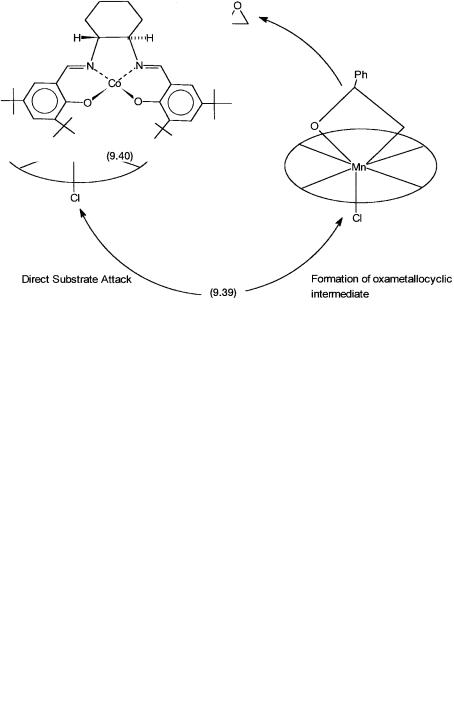
214 ASYMMETRIC CATALYSIS
Figure 9.9 Two alternative pathways for the oxygen atom transfer step. The righthand path involves formation of an oxametallocycle, whereas the left-hand path does not involve any such intermediate.
propylene oxide could be hydrolyzed with full theoretical yield and 98% enantioselectivity.
The precatalyst used in these water-based kinetic resolution reactions is the cobalt Schiff-base complex 9.40. Its structural similarity to the asymmetric epoxidation catalysts 9.38A and 9.38B is to be noted. In the actual catalytic system 9.40 is activated with small amounts of acetic acid and air to give a cobalt(III) complex where CH3CO2 and H2O are additional ligands. The mechanistic details of this reaction are as yet unknown.
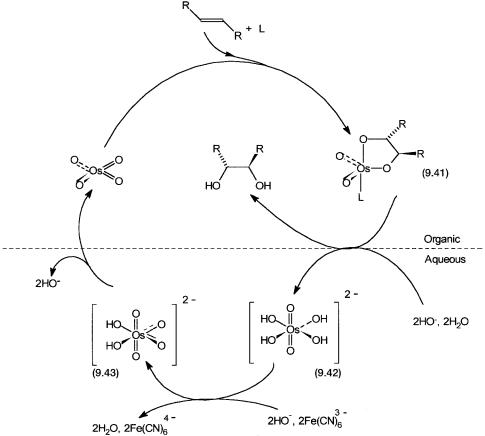
ASYMMETRIC DIHYDROXYLATION REACTION |
215 |
9.4ASYMMETRIC DIHYDROXYLATION REACTION
Osmium-mediated dihydroxylation of carbon–carbon double bonds with OsO4 is a classic reaction that can be made catalytic by using co-oxidants such as ButO2H or N-methylmorpholine N-oxide. For asymmetric dihydroxylation (ADH) reactions the co-oxidant of choice is the water-soluble [K3Fe(CN)6] salt. As shown in Fig. 9.10, in a biphasic system consisting of water and a waterimmiscible organic solvent, OsO4 reacts with the alkene to produce the glycolate 9.41. Coordination by a chiral ligand L to osmium ensures that this step is enantioselective. Owing to the solubility properties of OsO4, 9.41, alkene, and L, this step occurs in the organic phase.
Figure 9.10 Catalytic cycle for OsO4-catalyzed asymmetric alkene dihydroxylation. The dashed line represents the phase boundary between the organic and the aqueous phase. L is the chiral ligand, e.g., 9.44.
